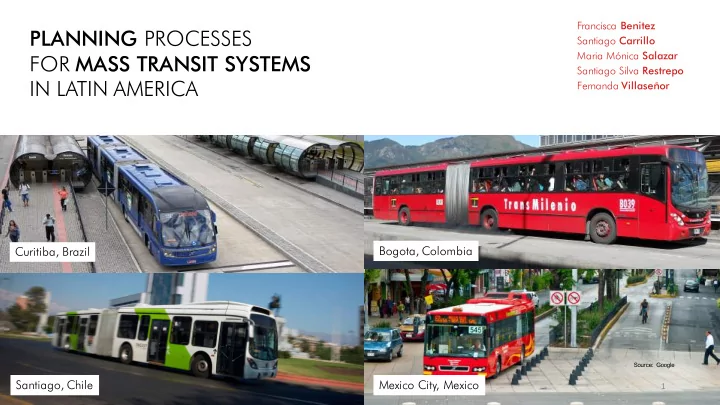

Francisca Benitez PLANNING PROCESSES Santiago Carrillo Maria Mónica Salazar FOR MASS TRANSIT SYSTEMS Santiago Silva Restrepo IN LATIN AMERICA Fernanda Villaseñor Bogota - Colombia Bogota, Colombia Curitiba, Brazil Santiago - Chile Source: Google Santiago, Chile Mexico City, Mexico 1
WHAT IS A BUS RAPID TRANSIT SYSTEM? Bus Rapid Transit (BRT) is a high quality bus-based transit system that delivers fast, comfortable, and cost-effective services at metro-level capacities Source: www.brtdata.org 2
SUMMARY 3
MARKET FAILURES THAT AFFECT URBAN MASS TRANSIT PROVISION o Unclear property rights on the curbside and on the road o Transporters collusion o Principal-agent problem between drivers and owners (incentives misaligned) o Congestion o Pollution
HOW BRT CAN HELP TO SOLVE THOSE MARKET FAILURES o Reserve tracks and restrictive access elevated stations (Platform-level boarding) o Fares can be set at the level a which they finance long-term cost provision o Private bus owners charge by Km, not per passenger, and drivers are employees with a fixed salary o Minimize congestion with busway alignment, wide doors and off-board fare collection
CURITIBA, THE FIRST EXPERIMENT o Initially planned in 1965, the Rede Integrada de Transporte began operations in 1974 o Curitiba has 1.87 million habitants and its BRT transports 0.56 million per day in 7 corridors with 123 stations and 83.9 Km o Standard fare $0.86 USD o Busses operate with Biodiesel and diesel
IMPLEMENTED IN 2000 TRANSMILENIO Bogotá, Colombia
Bogotá’s transportation system was one of the least efficient in the region. In terms of vehicles per capita, age of fleet, average speed on rush hour. However, the demand for public transportation was only comparable to Quito, Ecuador.
112.9 km and 14 km of ongoing construction o in carrera 7 137 stations (including six stations at calle 6 o and Soacha) 2,213,236 passengers per day and o 565,100,000 annual passenger boardings o 12 corridors (Calle 80, Caracas, Caracas Sur, o Eje Ambiental, Norte, Américas, NQS central, NQS sur, Suba, Calle 26, Carrera 10 and Carrera 7)
PROS Capacity (compared to prior model) o Efficiency in terms of number of trips and o users Primary stage of integrated transportation o system
CONS Centralized planning o Deficient exclusive road network. o Capacity (demand growth rate of o 12.8%)
METROBUS IMPLEMENTED IN 2005 Mexico City, Mexico
Baseline transportation prior to BRT 3.5 million passenger cars o 180,000 motorcycles o 130,000 taxis o 30,000 public transit buses o 200 kilometers subway o June 2005 o 125 km of exclusive bus lanes enabled o 177 stations throughout 6 lanes (corridors) o 1,065,000 passengers per day o Replaced 350 standard buses with 97 new o articulated BRT vehicles.
PLANNING PROCESS o 2002 World Resources Institute (EMBARQ-WRI) o 5-year agreement à Mexico City government, Ministry of Environment: Sustainable Transportation Program in Mexico City o Center for Sustainable Transportation, result of joint efforts of three entities: an international organization, EMBARQ-WRI; a government entity, the Government of Mexico City, and a Mexican non-governmental organization, the CeIBA.
METROBUS TRANSPORT PRIVATE PRIVATE TRUSTS COLLECTION ENTITIES ENTITIES ONE PRIVATE TRUST 10 FIRMS FIVE COMPANIES PER EACH LINE
TRANSANTIAGO IMPLEMENTED IN 2007 Santiago, Chile
“ The policy of low entry costs and unrestricted competition applied in the 1990s allocated resources inefficiently – competition among the buses, metro, and taxis generated a disorganized, nonintegrated system that forced users to assume a major monetary expense and use multiple forms of transportation. ” Font, M. (2015). Transantiago: Urban Development in Chile. In The State and the Private Sector in Latin America (pp. 157-178). Palgrave Macmillan US.
108 kms (67 miles) of exclusive bus lanes o enabled 11% bus quantity increase o Number of transactions per day: 3,227,563 o Number of bus stops: 11,325 o Created under an evolving framework and based on public-private collaboration . Network of institutional, business, and public actors running and supervising its components.
CONS Plan implementation and operation Bus frequency Technology failures Mayor political disagreements Failure to educate community
PROS Environmental Impact Smart card fare and collection system Increased Public Safety
TRANSMILENIO TRANSANTIAGO METROBUS Bogotá Santiago México City Local Authorities, International PLAN DESIGN Local Authorities Private-Public partnership Non-Profit and local NGO PLAN Local Authorities National Government Local Authorities IMPLEMENTATION Global Environmental Fund National, Local and Multilateral FINANCING Government Subsidy Shell Foundation Bank Government of Mexico City Major political • Capacity • disagreements in the Opposition groups Centralized planning • • MAIN CHALLENGES implementation phase Negative spillovers on Levels of service • • High expectations • secondary routes
FINAL REMARKS • Ideally, a scheme of decentralization in the provision of public services should be under the responsibility of the level of Government that responds directly to the users and beneficiaries of this. • However, centralized planning is often used to minimize the high costs of investment and deficiencies in technical knowledge for local authorities. • This results in a process of coordination between different levels of Government that many times ends in the imposition of the national agenda over the local one.
Recommend
More recommend